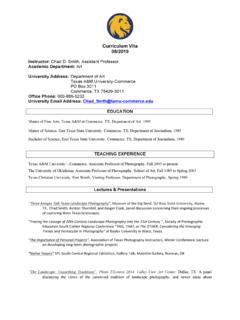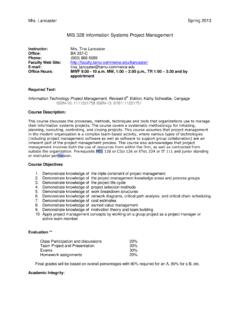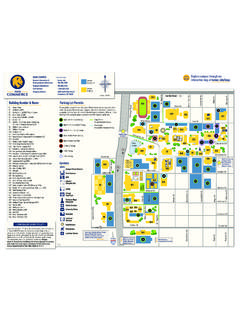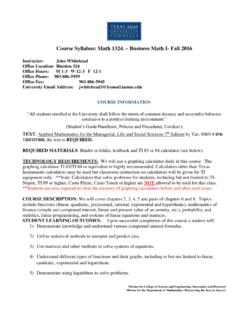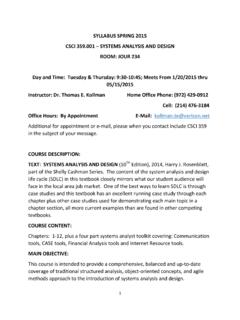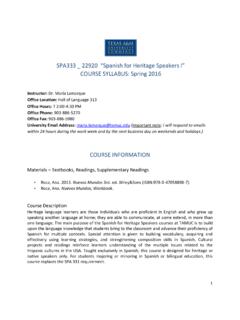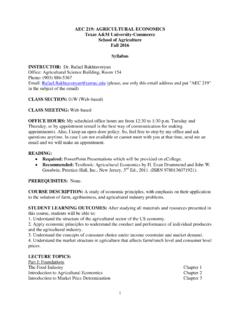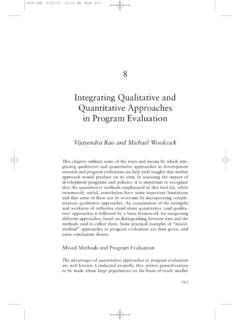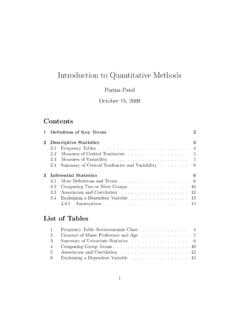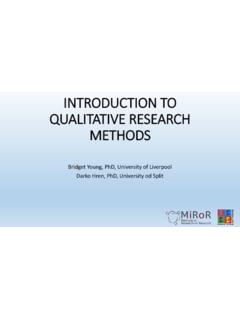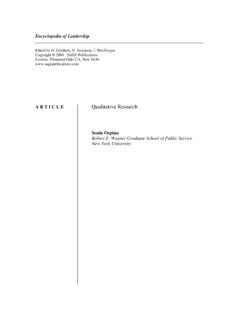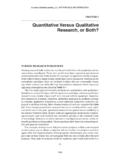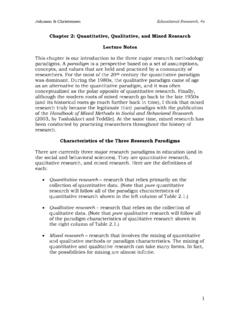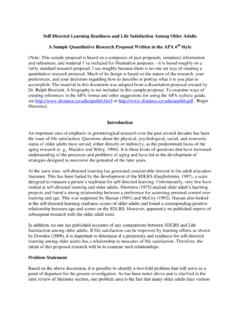Transcription of Quantitative vs. Qualitative - Texas A&M University-Commerce
1 Focus groups Section 1 Sub-heading Slide # Introduction Literature Review: Why is it important? A Good Literature Review 3 4 5 Introduction 0 Two main traditions1 in research: Quantitative and Qualitative 0 Quantitative research = inferential research 0 Qualitative research = interpretive research 0 Both different in terms of goals, applications, sampling procedures, types of data, data analysis, etc. 0 Although different, they can be complementary of one another , in mixed methods2 Literature Review 0No matter the tradition you choose, you must critically review all scholarly literature relevant to your topic. 0 Start with How to Read a Scientific Article 0It is imperative to know what s been written on your topic AND where your study will fit into the current literature base.
2 0A good literature review is a synthesis of available research which arises from the analysis of the sources accessed to produce a summary of the knowledge on your t o pi c . 3 0 ..focus on discussion of method and results rather than an author s interpretations of their results. Knowledge is advanced through critical examination of methods and results as a way of resolving disparate interpretations. 4 Why is it so important? A Good Literature ..is/ ..is/does Synthesis of available research Critical evaluation Breadth/Depth Clarity/Conciseness Rigorous/Consistent/Comprehensive search strategy Includes various viewpoints Critical in positive & negative ways Presents an argument based on literature only Focused on the research question Produces a basis for your research AND one or more researchable question(s) An annotated bibliography Confined to description Narrow/Shallow Confusing/Long-winded Constructed in an arbitrary way Presentation of only your viewpoint Opinionated, uncritical, over-generalized, unfocused Unsupportive of the research question Adapted from Figure 1 in Marshall, Gill.
3 (2010). a literature third in a series. Synergy: Energy & Therapy Practice, 20-23. Retrieved from Section 2 Sub-heading Slide # Overview of differences Basic characteristics Purpose Research questions Research questions cont d 7 8 9 10 11 Overview of Differences The Qualitative and Quantitative research traditions are different in many ways. This presentation will address some of them: Basic characteristics Purpose Types of questions asked Sample traits Sampling procedures Data types Data analysis Establishing reliability Establishing validity Generalizability of findings See the following links for some good comparison charts: Basic characteristics Quantitative research Qualitative research reasoning research question(s) inferences relationships among variables predictions causation theory results reasoning a topic an understanding of what/who is being studied phenomena theory Purpose Quantitative Qualitative 0 Studying everyday life 0 Exploring lived experiences 0 Taking on participants points of view 0 Discovering patterns in behavior/ phenomena 0 Conducting experiments 0 Testing hypotheses 0 Determining association (relationships between variables) 0 Finding correlation OR 0 Causation The main objective in Quantitative research is to test theory.
4 Researchers do this by: The main objectives in Qualitative (action) research are to build theory and essentially solve problems. Researchers do this by: ? Research Questions Quantitative Qualitative 0 Narrow 0 Seeks explanation 0 Includes 2 or more variables 0 Indicates perceived relationship 0 Hypotheses based on data from previous research 0 Broad 0 Seeks to explore 0 Variables not necessarily included 0 Relationships emerge throughout the research process 0No hypotheses necessary Note: There are always exceptions! a)Broad a)Ex: Are females smarter than males? 5 b)Vague a)Ex: Why did the chicken cross the road? 5 c)Compound a)Ex: Q1- Are people who do yoga generally happier than those who don t and are those who do yoga weekly happier than those who do it less?
5 D)Already answered e)Irrelevant f)Immeasurable a)Narrow a)Ex: Do females age 18-35 score higher than adult males age 18-35 on the WA I S-III? 5 b)Precise a)Ex: What are some of the environmental factors that occurred in Durham, NC between January and February 2014 that would cause chickens to cross Broad Street? 5 c)Non-compound a)Ex: Q1-Are people who do yoga generally happier than those who don t? Q2-Does frequency of yoga attendance impact happiness scores? d)New/fresh e)Relevant f)Measurable ? Research Questions cont d ? Bad Good ! Please read What makes a good research question Sample traits Sampling procedures Data types Data analysis Qualitative Data Analysis Reliability, validity, .. Establishing Reliability Establishing Validity Importance of Bracketing Conclusion 13 14 15 16 17 18 19 20 21 22 Section 3 Sub-heading Slide # Sample Traits Quantitative Qualitative 0 Sample size very important for statistical analysis 0 Typically larger 060+ participants (at least 30 per group) 0N should be appropriate for the statistical tests/ methods of analysis and research question(s) 0 Must be representative of the population being studied 0 N is not as important 0 Usually smaller 0 Phenomenology: 1-50 0 Ethnography: 30-50 0 Grounded theory: 30-50 0 Ethological studies.
6 100-2006 0 Researchers strive for saturation 0 Not necessarily representative of the population Sampling Procedures Quantitative Qualitative 0 Sometimes randomly selected ( , probability sampling) 0 Often purposefully selected (convenience) 0 Frequently randomly assigned to groups 0 Most often anonymous 0 Most often purposeful 0 Purposive sampling 0 Convenience 0 Snowball 0 Criterion 0 Deviant case 0 Opportunistic, etc. 0 Identified, not anonymous Data Types Quantitative7 Qualitative8 0 Must be measurable and quantifiable 0 Nominal 0 Ordinal 0 Dichotomous 0 Interval 0 Ratio 0 Numeric form 0 Surveys 0 Closed-ended questions 0 Tests/Inventories 0 Questionnaires 0 Observations (non-participant, partial participant, participant) 0 Interviews (individual, focus groups, etc.)
7 0 Documents 0 Audiovisual materials (photos, CDs, videos, etc.) Categorical Note: Many more examples exist. This is not an exhaustive list. Continuous Data Analysis Quantitative9 Qualitative10 0 Descriptive statistics 0 Measures of central tendency -- mean, median, mode 0 Measures of spread -- range, variance, deviation 0 Inferential statistics 0 Estimation of parameter 0 Testing of hypotheses 0 Run tests using statistical software packages (SPSS, SAS, Stata, etc.) 0 Appropriate tests depend on variable types & research questions! and organize data a)Transcribe verbal data to written data b)Organize data for manageability & take notes/memo , classify, interpret a)Coding vivo codes codes b)Themes and visualize a)Comparison table b)Hierarchical tree, etc.
8 Qualitative Data Analysis (QDA) Researchers conducting Qualitative research often choose to use Computer Assisted Qualitative Data Analysis tools/software rather than coding manually, by hand. These tools can aid researchers in completing the meticulous task of organizing and coding often extensive amounts of data. Many of the available programs also offer visualization tools (graphs, charts, etc.) for presentation. Some of the QDA programs available online include: HyperRESEARCH WordStat The purpose of establishing reliability, validity, and/or trustworthiness in research is essentially to ensure data are sound and replicable and that studies are accurate. Techniques used to establish reliability and validity in Quantitative research are clear and well-established.
9 There are particular steps to take when attempting internal validity, test-retest reliability, etc. Many of these steps can be completed by a couple clicks of a mouse. On the other hand, the steps to obtaining trustworthiness in Qualitative research are more ambiguous and less established. Relevant literature even lacks a consensus on what to call this process. Some of the most common terms used to describe this process include trustworthiness, authenticity, goodness, and Reliability, Validity, and/or Trustworthiness Establishing Reliability Would your study/instrument yield the same results if repeated? Quantitative Reliability Qualitative Trustworthiness 0Te s t-retest .. 0 Inter-r a t e 0 Parallel 0 Internal 0 Saturation 0 Triangulation 0 Member checking 0 Collaboration 0 Thick, rich description 0 Peer debriefing8 Note: this is not an exhaustive list Establishing Validity Quantitative Validity Trustworthiness cont d 0 Internal validity 0No confounding variables!
10 0 External validity 0 Face validity 0 Construct validity 0 Formative validity 0 Sampling validity9 0 Reflexivity..the writer is conscious of the biases, values, and experiences that he or she brings to a Qualitative research s t u dy. 10 It is not possible to view without viewing from somewhere. 11 0 Bracketing.. a n investigator s identification of vested interest, personal experience, cultural factors, assumptions, and hunches that could influence how he or she views the study s data. 11 1. identification and temporary setting aside of the researcher s assumptions. 11 2. hermeneutic revisiting of data and one s evolving comprehension of it in light of a revised 11 Note: See Other Resources Mentioned for more confounding variables resources.
